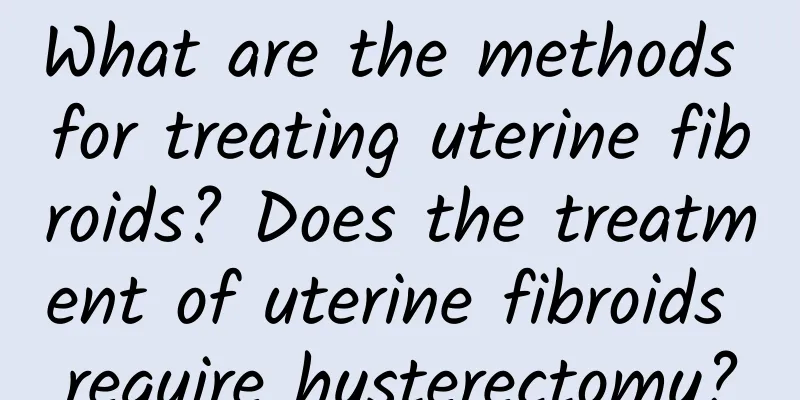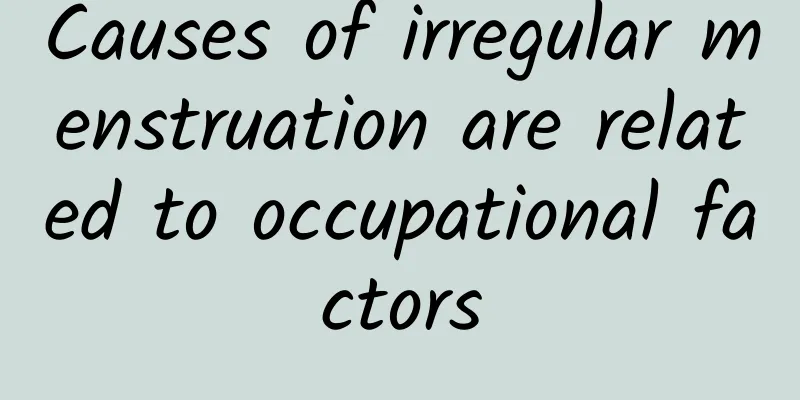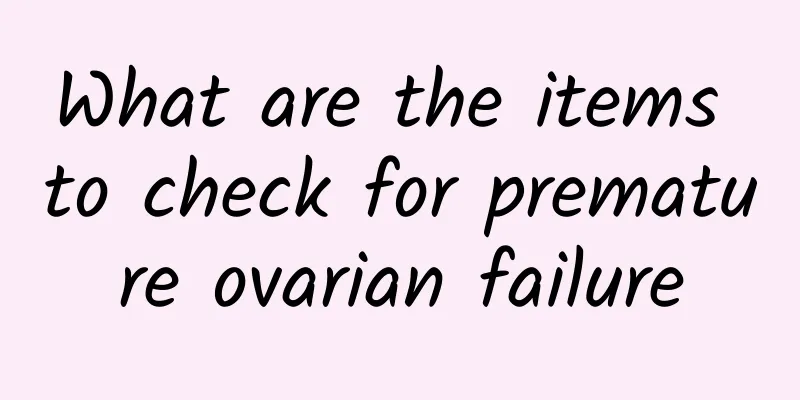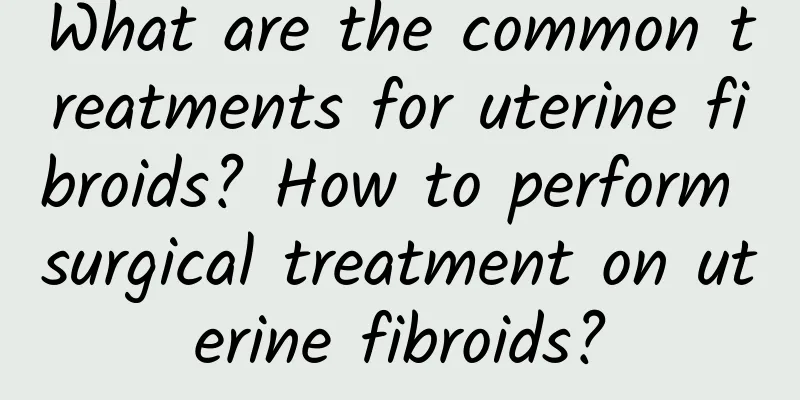What are the methods for treating uterine fibroids? Does the treatment of uterine fibroids require hysterectomy?

|
Does uterine fibroids require a hysterectomy? Uterine fibroids do not necessarily require hysterectomy. The specific treatment method depends on the condition of the uterine fibroids. 1. Treat with medication Short-term treatment is mainly suitable for patients with uterine fibroids to correct anemia, reduce uterine volume, avoid intraoperative bleeding, and reduce surgical difficulties; for menopausal women whose uterus is smaller than 10 weeks of pregnancy and whose symptoms are mild; for other complications with contraindications to surgery and side effects of drugs, it is not suitable for long-term use. 2. Surgical treatment Surgery is still the most common treatment for uterine fibroids. It is mainly divided into hysterectomy and myomectomy. (1) Hysterectomy: If there is an indication for surgery, fertility preservation is not necessary or malignant changes are suspected, hysterectomy is feasible. Since the cervix may become cancerous in the future after subtotal hysterectomy, the treatment of residual cancer is very difficult, so total hysterectomy is recommended for most patients. Cervical smear cytology should be performed before surgery to eliminate malignant cervical lesions. Premenopausal women can retain both adnexa and consider removing both adnexa at the same time after menopause. The surgery can be performed abdominally, laparoscopically, or vaginally, depending on the size of the uterus, the location of the fibroids, pelvic and abdominal adhesions, abdominal and vaginal conditions (such as obesity, etc.), the equipment and technical conditions of the doctor and hospital. (2) Myoma removal: Myoma removal can be considered for patients ≤ 40 years old who wish to maintain their fertility or who do not want to have their uterus removed. Before surgery, vaginal examination B should be performed to fully understand the size, location, and number of myomas, and the appropriate method (laparotomy, laparoscopy, hysteroscopy, or negative) should be selected for myoma removal. Laparoscopy is a popular minimally invasive surgical method with less trauma and faster recovery. However, laparoscopy requires high technical skills of doctors. At the same time, since laparoscopy has no sense of touch, it is generally only suitable for removing single or small amounts of subserous or intramural fibroids. There is no unified opinion at present. It is generally recommended that a single fibroid should not be too large (no more than 10-375px), the number should not be too many (no more than 3-4, the diameter should be less than 5-150px fibroid nodules, etc. Hysteroscopic surgery is suitable for submucosal fibroids, but only a few type 2 submucosal fibroids protrude from the uterine cavity may not be able to be removed at one time. Open abdominal myoma removal has a wide range of indications. For myomas in special locations, multiple myomas, large uterus, and postoperative recurrence, open abdominal myoma removal should be the first choice. With the help of the surgeon's sense of touch, all the myoma nodules that are touched in the uterus can be removed as much as possible, which is more suitable for young people who have fertility requirements. 3. Traditional Chinese Medicine Traditional Chinese medicine believes that uterine fibroids are caused by organ dysfunction, qi stagnation and blood stasis. Therefore, the main treatment of uterine fibroids with traditional Chinese medicine is to activate blood circulation and remove blood stasis, eliminate blood stasis and disperse knots, clear away heat and detoxify, soothe the liver and regulate qi, and remove blood stasis and relieve pain. Let's take a look at how to treat uterine fibroids with traditional Chinese medicine. 4. Diet therapy Eat nutritious dried fruits regularly, such as peanuts, sesame seeds, melon seeds, etc. Traditional Chinese medicine treatment of uterine fibroids can improve the blood circulation of the hyperplastic endometrium, gradually eliminate simple hypertrophy of the myometrium, soften the hyperplastic connective tissue, regulate menstruation, stop bleeding, eliminate pain, and restore ovarian function. It can effectively control the growth of uterine fibroids, gradually soften the tumor, and eventually dissipate. Traditional Chinese medicine has a unique method for treating uterine fibroids, which appears in the form of black ointment. Black ointment plays an important role in the field of traditional Chinese medicine treatment and is one of the souls of traditional Chinese medicine treatment. It masters the theory of internal and external treatment, uses internal and external treatment, and the efficacy penetrates the lesion position without harming the kidneys to achieve the purpose of treatment. This method has successfully cured many female friends and has received a lot of praise. Basically, traditional Chinese medicine treatment of uterine fibroids is mainly to promote blood circulation, eliminate silt, eliminate symptoms, regulate qi stagnation, correct solids, and achieve the purpose of hemostasis, tumor elimination, and rejuvenation. How are uterine fibroids caused? The etiology of uterine fibroids is still unclear and may involve a complex interaction between normal myometrial cell mutations, sex hormones, and local growth factors. Uterine fibroids are hormone-dependent tumors. Estrogen is the main factor that promotes the growth of fibroids. Some scholars believe that growth hormone (GH) is also related to the growth of fibroids. GH can promote mitosis in coordination with estrogen and promote the growth of fibroids. They also speculate that human placental lactogen (HpL) can also promote mitosis in coordination with estrogen. They believe that the accelerated growth of uterine fibroids may be related to the high hormone environment of pregnancy and HpL is also involved. In addition, ovarian function and hormone metabolism are controlled and regulated by higher nerve centers, so nerve center activity may also play an important role in the onset of fibroids. Uterine fibroids are common in women of childbearing age, widowed women, and women with uncoordinated sexual lives. Chronic pelvic congestion may also be one of the causes of uterine fibroids. In short, the occurrence and development of uterine fibroids may be the result of the combined action of multiple factors. |
Recommend
What is the cause of pelvic effusion?
Infertility experts say that if women are affecte...
How to check if it is
Virginity can be checked through medical examinat...
Patients with cervical hypertrophy should undergo examination as soon as possible
Cervical hypertrophy is a common gynecological di...
What should patients with vaginitis pay attention to in terms of diet?
No matter what kind of disease you have, there ar...
Can I have an IUD if I have chronic pelvic inflammatory disease?
Can I have an IUD if I have chronic pelvic inflam...
What medicine should women take for irregular menstruation? If the medicine is taken correctly, menstruation will become normal naturally.
Menstrual irregularities are very common in our d...
The most eye-catching in summer! Easily exercise the vest line and mermaid line
In the height of summer in August, the things you...
Don’t eat rice or bread to lose weight ~ The result of “sugar-restricted diet” is myocardial infarction!
People who want to get rid of obesity and lose we...
What is the difference between early miscarriage and menstruation?
There are certain differences between early misca...
6 signs of menopause in women
Symptoms of premenopause vary from woman to woman...
What are the symptoms of cervicitis?
In today's life, cervicitis is mainly caused ...
Stay away from Pu'er tea during menstruation to prevent dysmenorrhea
Women will experience discomfort when their menst...
What are the main symptoms of chronic pelvic inflammatory disease?
What are the main symptoms of chronic pelvic infl...
How does pelvic inflammatory disease develop?
Pelvic inflammatory disease is mainly a pathologi...
What are the symptoms of cervical erosion in women? Experts explain the symptoms of cervical erosion in detail
What are the symptoms of cervical erosion? This i...









